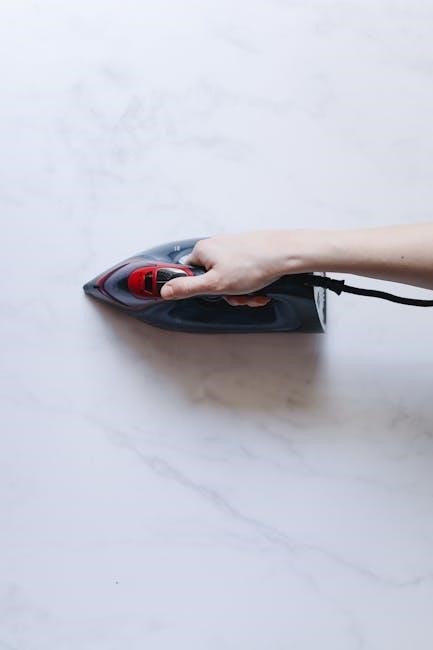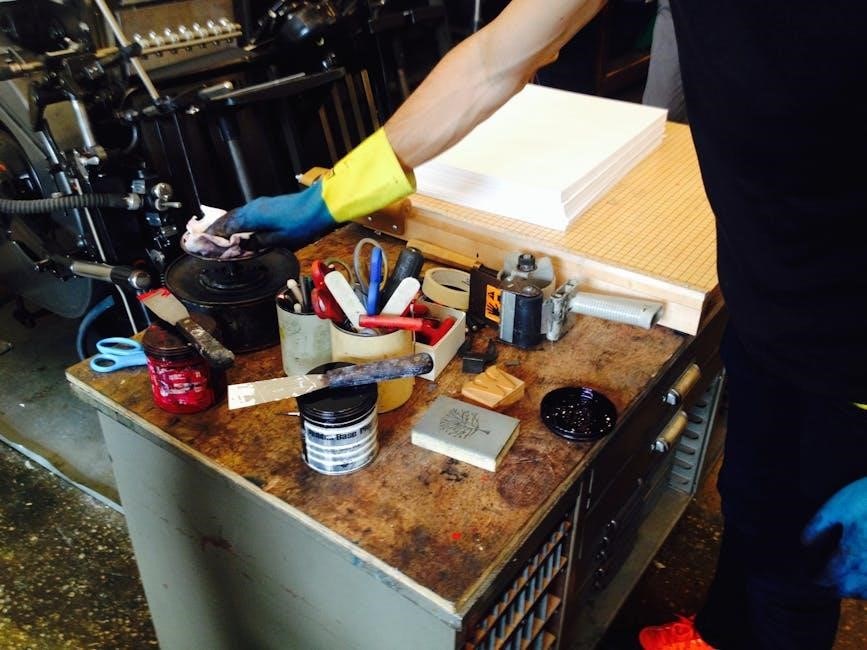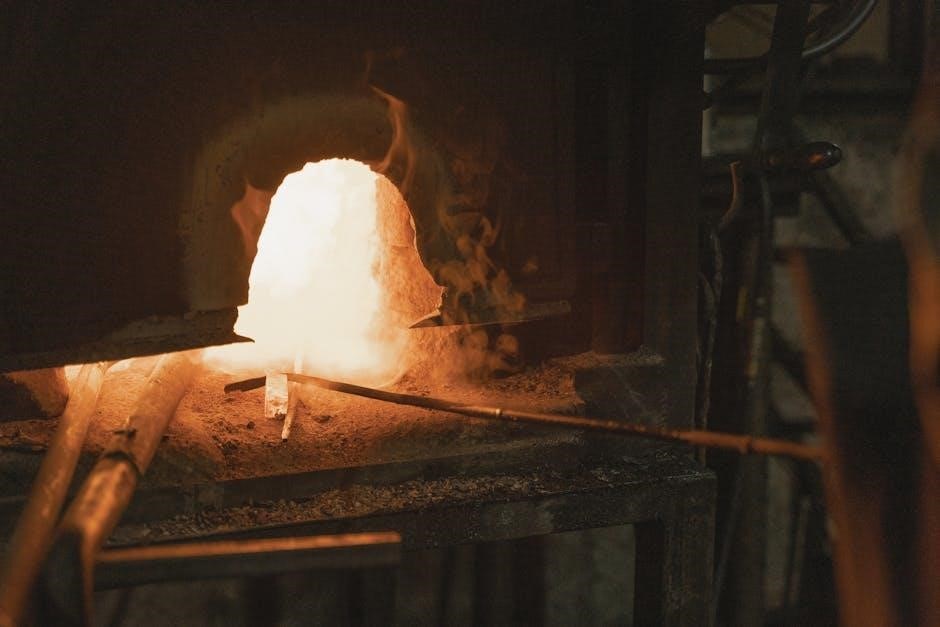A heat press manual is an essential guide for understanding machine operation, setup, and maintenance. It provides detailed instructions for optimal performance and troubleshooting, ensuring safe and effective use. PDF versions are widely available for various brands, offering comprehensive resources for users.
1.1 Importance of Heat Press Manuals
Heat press manuals are crucial for ensuring proper machine setup, operation, and maintenance. They provide step-by-step guides for optimal performance, troubleshooting, and safety precautions. With a manual, users can avoid damaging materials or the machine itself. Manuals also include specific temperature and time settings for various materials, ensuring consistent results. They serve as a comprehensive resource for resolving common issues and maintaining equipment longevity. Accessing a PDF manual allows users to easily reference instructions anytime, making them indispensable for both beginners and experienced operators.
1.2 What to Expect in a Heat Press Manual
A heat press manual is a comprehensive guide detailing machine setup, operation, and maintenance. It typically includes step-by-step instructions for initial assembly, temperature calibration, and usage procedures. Manuals also cover troubleshooting common issues, safety precautions, and material-specific settings. They often provide diagrams and technical specifications, such as maximum temperature limits and recommended pressure levels. Additionally, manuals may include tips for optimizing print quality and extending machine lifespan. PDF versions are commonly available, making it easy to access and reference the information digitally. This ensures users can operate their heat press safely and effectively.

Understanding Heat Press Components
A heat press consists of key components like the heat platen, control box, and pressure adjustment mechanism. These parts work together to ensure precise temperature and pressure control.
2.1 Key Parts of a Heat Press Machine
A heat press machine comprises essential components like the heat platen, control box, pressure adjustment knob, and thermal insulation layers. The heat platen is the heating element, while the control box manages temperature and timer settings. The pressure knob ensures even force application. Additional parts include a digital display for monitoring settings and safety features like emergency release. These components work together to achieve precise heat transfer and consistent results. Proper understanding of each part is crucial for efficient operation and maintenance, as outlined in the manual.
2.2 Control Box and Connection Methods
The control box is the brain of the heat press, managing temperature, timer, and pressure settings. It typically features a digital display for precise adjustments. Connection methods involve linking the heat platen, temperature sensors, and pressure components to the control box. Proper wiring ensures safe and efficient operation. The plus/minus keys allow users to set desired temperatures (usually between 180-200°C) and time. Parameter settings, such as countdown timers, are also controlled here. Always refer to the manual for specific connection diagrams and instructions to avoid malfunctions and ensure optimal performance.

Setting Up Your Heat Press
Initial setup involves assembling the machine, placing sublimation paper correctly, and calibrating temperature and time settings as per the manual. Double-check all connections before use.
3.1 Initial Setup Instructions
Begin by unpacking and assembling your heat press machine according to the provided instructions. Ensure all parts are securely attached and the workspace is clear. Next, plug in the machine and allow it to preheat to the recommended temperature, usually between 180-200°C. Place the sublimation paper with the printed side down on the garment. Follow the manual’s guidelines to align the heat plate correctly. Double-check all connections and settings before proceeding to press. Always refer to the PDF manual for specific brand instructions to ensure proper setup and safety.
3.2 Calibrating Your Heat Press
Calibrating your heat press ensures accurate temperature and pressure settings. Start by preheating the machine to the recommended temperature, then use a thermometer to verify the heat platen’s accuracy. Adjust the temperature and pressure according to the manual’s instructions. For precise calibration, some manuals suggest using a test print on scrap material. Ensure the pressure is evenly distributed across the platen. Regular calibration prevents uneven transfers and extends the machine’s lifespan. Always refer to the PDF manual for specific calibration steps tailored to your heat press model.
Operating Instructions for Heat Press Machines
Operating instructions guide users through setup, temperature control, and pressing techniques. Manuals include step-by-step processes, material-specific settings, and troubleshooting tips for optimal results. Always refer to brand-specific PDFs for detailed guidance.
4.1 General Operating Guidelines
General operating guidelines provide foundational steps for using a heat press safely and effectively. Begin by preparing the machine according to the manual, ensuring all parts are securely connected. Preheat the press to the recommended temperature, typically between 180-200°C for most materials. Always use a timer to avoid overheating. Place the transfer material correctly, ensuring proper alignment. Apply consistent pressure and avoid overloading the press. Keep the workspace clean and well-ventilated. Refer to the PDF manual for specific settings and safety tips to achieve professional results. Regularly inspect the machine for wear and tear to maintain performance.
4.2 Step-by-Step Usage Guide
Step 1: Power on the heat press and set the desired temperature using the MODE button and plus/minus keys. Step 2: Prepare the garment and place the transfer material correctly. Step 3: Position the item on the heat press, ensuring proper alignment. Step 4: Close the heat plate and start the timer. Step 5: Allow the cycle to complete, then carefully remove the item. For double-sided printing, insert cardboard between layers to prevent re-heating. Always refer to the PDF manual for specific settings and safety guidelines to ensure optimal results.

Temperature and Time Settings
Temperature and time settings are crucial for achieving optimal results. Typical ranges are 180-210°C for temperature and 10-30 seconds to several minutes for time, depending on material type. Always consult the manual for specific guidelines to ensure proper application and avoid damage.
5.1 Recommended Temperature Ranges
Recommended temperature ranges vary by material. Heat transfer vinyl typically requires 180-210°C, while sublimation paper may need 190-200°C. Cotton fabrics often require 180-200°C, and synthetic materials like polyester may need higher temperatures. Always refer to the specific material manufacturer’s guidelines for precise settings. Proper temperature ensures optimal transfer quality and prevents damage to the press or substrate. Adjusting these settings incorrectly can lead to poor results or machine malfunction, making it essential to follow the manual’s instructions carefully.
5.2 Adjusting Temperature and Time
Adjusting temperature and time is crucial for achieving optimal results. Use the control panel to set precise temperatures and timers. For heat transfer vinyl, typical settings are 180-210°C for 10-20 seconds. Sublimation paper may require 190-200°C for 30-60 seconds. Always refer to the material manufacturer’s guidelines. Overheating can damage substrates, while underheating may result in incomplete transfers. Fine-tune settings based on trial and error, ensuring consistent results. Proper calibration ensures longevity of the heat press and guarantees professional-quality finishes for various projects. Follow the manual’s instructions for accurate adjustments to achieve desired outcomes every time.

Heat Press Maintenance and Care
Regular maintenance ensures longevity. Clean the heat press after use, cover it when idle, and inspect electrical components regularly for optimal performance and safety.
6.1 Daily Maintenance Tips
Regular cleaning of the heat press is crucial. Use a soft cloth to wipe down surfaces, removing debris and ink residue. Check and tighten loose bolts periodically. Inspect the power cord and plug for damage. Store the machine in a dry, cool place when not in use. Apply a silicone-based lubricant to moving parts to prevent rust. Ensure the heat platen is free from dust and moisture. Refer to your heat press manual for specific care instructions tailored to your model for optimal performance and longevity.
6.2 Deep Cleaning the Heat Press
For deep cleaning, unplug the heat press and allow it to cool completely. Use a damp cloth with a mild detergent to wipe down surfaces, paying attention to the heat platen and surrounding areas. Avoid harsh chemicals or abrasive materials that could damage the machine. Remove any stubborn residue with a gentle scrubber. Dry thoroughly with a clean cloth to prevent water spots. Regular deep cleaning ensures optimal performance and prevents ink or debris buildup. Always consult your heat press manual for specific cleaning recommendations tailored to your model.
6.3 Replacing Parts and Accessories
Replacing parts and accessories on your heat press is crucial for maintaining performance. Always turn off and unplug the machine before starting. Identify worn-out components like the heating element, pressure pads, or cables. Use manufacturer-approved replacement parts to ensure compatibility and safety. Refer to your heat press manual for specific instructions and torque settings. Regularly check for updates or recalls on parts. Order replacements from trusted suppliers or the manufacturer’s official website. Proper installation ensures optimal functionality and prevents damage. Keep a record of replaced parts for future reference and maintenance planning. Follow all safety guidelines during the replacement process.

Safety Precautions
Always wear protective gloves and eyewear when operating a heat press. Ensure proper ventilation and keep flammable materials away. Avoid overheating, as it can cause burns or fires. Maintain a clean workspace and keep children away. Follow manual guidelines to prevent accidents and ensure safe operation. Regularly inspect the machine for damage or wear.
7.1 Essential Safety Tips
Essential safety tips for heat press operation include wearing protective gear like gloves and eyewear to prevent burns and injuries. Ensure the workspace is well-ventilated to avoid inhaling fumes from materials like sublimation ink or heat transfer vinyl. Keep flammable materials away from the press to reduce fire hazards. Regularly inspect the machine for worn-out parts or damage, andReplace them promptly to maintain safety. Avoid touching hot surfaces and always follow the manufacturer’s guidelines for temperature and time settings. Keep children and pets away from the heat press while it is in operation.
7.2 Avoiding Common Hazards
Avoiding common hazards with a heat press involves preventing burns by using heat-resistant pads when handling hot surfaces. Never leave the machine unattended while it’s operating, as unintended accidents can occur. Ensure proper placement of transfers to avoid misalignment, which can damage materials or the press. Regular maintenance, such as cleaning and lubricating moving parts, prevents mechanical failures. Always unplug the machine during cleaning or repairs to eliminate electrical shock risks. Following these precautions ensures a safer working environment and prolongs the lifespan of your heat press.
Troubleshooting Common Issues
Common heat press issues include incorrect temperature settings, uneven pressure, or faulty heating elements. Refer to error codes in your manual for specific solutions and adjustments to resolve these problems efficiently.
8.1 Identifying and Solving Problems
Identifying issues with your heat press often starts with observing unusual behavior, such as uneven heating or error codes. Consult your manual for a list of common problems and their solutions. For example, temperature fluctuations may require recalibrating the machine, while pressure issues could indicate worn pads needing replacement. Always refer to the troubleshooting section in your PDF manual for step-by-step guidance. Regular maintenance, like cleaning and updating settings, can prevent many common problems. Follow manufacturer instructions to ensure optimal performance and extend the lifespan of your heat press.
8.2 Error Codes and Solutions
Heat press manuals often include sections dedicated to error codes, providing clear solutions for common issues. For example, an “E1” code may indicate a temperature sensor malfunction, while “E2” could signal a heating element problem. Referencing the PDF manual, users can identify the specific error and follow troubleshooting steps, such as recalibrating the machine or replacing faulty components. Some manuals also guide users on resetting error codes by pressing and holding specific buttons, like the “MODE” button. Always consult the manual for precise instructions to resolve errors efficiently and safely.

Heat Press Manuals for Specific Brands
Heat press manuals for specific brands like Hotronix, Secabo, VEVOR, and HTVRONT are available as downloadable PDFs. These guides include setup instructions, operating steps, and troubleshooting tips for each model.
9.1 Hotronix Heat Press Manuals
Hotronix heat press manuals provide comprehensive guides for setup, operation, and maintenance. Available as downloadable PDFs, these manuals cover temperature settings, replacement parts, and troubleshooting. They ensure optimal performance for all Hotronix models, including the popular MAXX and Phoenix series. Users can find detailed step-by-step instructions for various materials and advanced techniques, making them indispensable for both beginners and experienced operators. Regular updates and technical support further enhance their utility, ensuring safe and efficient heat pressing experiences.
9.2 Secabo Heat Press Manuals
Secabo heat press manuals are essential resources for optimal machine operation. Available as downloadable PDFs, these guides cover setup, operation, and maintenance for models like the TC-30 and TC-38. They provide detailed temperature settings (180-210°C) and usage steps for various materials. Troubleshooting tips and safety precautions are also included. These manuals are crucial for professionals and hobbyists alike, ensuring safe and effective use of Secabo heat presses. Regular updates and clear instructions make them indispensable for achieving professional-grade results in heat transfer applications.
9.3 VEVOR Heat Press Manuals
VEVOR heat press manuals provide comprehensive guides for setup, operation, and maintenance. Available as PDF downloads, these manuals detail temperature settings (up to 210°C) and usage steps for various materials. They include troubleshooting tips and safety precautions, ensuring optimal performance. With clear instructions for initial heating temperature setup and material-specific guidelines, VEVOR manuals are invaluable for both professionals and hobbyists. Regular updates and technical specifications, like machine dimensions and heat platen sizes, make these resources essential for achieving high-quality results in heat transfer applications.
9.4 HTVRONT Heat Press Manuals
HTVRONT heat press manuals are available in PDF format, offering detailed usage steps, material settings, and troubleshooting solutions. These guides are designed to help users optimize their heat pressing experience. Manuals include step-by-step instructions for temperature and time settings, ensuring proper application for various materials. Troubleshooting sections address common issues, while maintenance tips extend machine longevity. Safety precautions and technical specifications are also highlighted, making HTVRONT manuals a valuable resource for both professionals and hobbyists seeking to achieve consistent, high-quality results in their heat transfer projects.
Material-Specific Heat Press Settings
Adjust settings based on material type, such as heat transfer vinyl or sublimation paper. Typical temperatures range from 180°F to 400°F, with time settings varying from 10 to 300 seconds. Always refer to manufacturer guidelines for specific materials to ensure proper adhesion and avoid damage. Optimal results depend on precise temperature, pressure, and time configurations for each substrate.
10.1 Heat Transfer Vinyl Settings
Heat transfer vinyl requires specific settings for optimal results. Typical temperature ranges from 300°F to 350°F, with press time between 10-20 seconds. Pressure should be medium to high, depending on the vinyl type. Standard vinyl settings are 320°F for 15 seconds, while metallic or holographic vinyl may need lower temperatures (300°F) and shorter times (10-12 seconds). Always refer to the manufacturer’s guide for exact settings, as variations exist between brands and finishes. Proper calibration ensures vibrant, durable designs with minimal risk of peeling or cracking. Testing on scrap fabric is recommended for perfect results. Settings may vary slightly based on material thickness and color.
10.2 Sublimation Paper Settings
For sublimation paper, recommended heat press settings typically range from 200°C to 210°C (392°F to 410°F) with a press time of 180 to 300 seconds. Medium to high pressure is essential for proper ink transfer. Ensure the paper is placed with the printed side down and use a protective sheet to prevent ghosting. Pre-pressing the substrate for 5-10 seconds before applying the paper is advised. Mirror or flip the design as needed. Always calibrate the heat press for sublimation-specific settings to achieve vibrant, long-lasting images. Testing on scrap fabric is recommended to optimize results. Adjustments may vary based on the substrate material and thickness.
10.4 Fabric and Material Compatibility
Fabric compatibility varies based on heat press settings. Cotton, polyester, and blends are common materials for heat transfer. Sublimation works best on polyester, while heat transfer vinyl suits cotton and blends. Silk and nylon require lower temperatures to prevent damage. Always pre-wash fabrics to remove finishes that may hinder ink adhesion. Use a temperature range of 180-220°C (356-428°F) for most materials. Ensure the fabric is dry and free of moisture before pressing. Testing on a small area first is recommended to ensure color retention and durability. Adjustments may be needed for sensitive or specialty fabrics to avoid scorching or discoloration. Proper material selection ensures optimal results and longevity of the design.

Advanced Heat Press Techniques
Advanced techniques include multi-layer pressing for complex designs and double-sided printing for seamless results. These methods enhance precision and durability, ensuring vibrant and long-lasting finishes on various materials.
11.1 Multi-Layer Heat Pressing
Multilayer heat pressing involves applying multiple transfers on a single substrate for intricate designs. This technique requires precise temperature and time adjustments to ensure each layer adheres correctly without damaging previous ones. Proper alignment and pressure are crucial to avoid misregistration. Using a heat-resistant paper between layers prevents direct contact, reducing the risk of overheating. This method is ideal for complex graphics and textured materials, offering a professional finish. Always refer to your heat press manual for specific settings and guidelines tailored to your machine and material type.
11.2 Double-Sided Printing Tips
Double-sided printing requires careful alignment to ensure designs on both sides are properly registered. Use a heat-resistant paper or cardboard between layers to prevent overheating. Apply even pressure and moderate temperature settings to avoid distorting the material. Allow the first side to cool completely before flipping and pressing the second side. Refer to your heat press manual for specific time and temperature guidelines. This technique is ideal for custom apparel and fabric projects, ensuring a professional finish with minimal effort and optimal results.

PDF Resources for Heat Press Manuals
PDF resources for heat press manuals provide comprehensive guides for setup, operation, and troubleshooting. They include detailed instructions for Hotronix, Secabo, VEVOR, and HTVRONT models, ensuring optimal use.
12.1 Downloading Heat Press Manuals
Downloading heat press manuals is straightforward, with PDF versions available for Hotronix, Secabo, VEVOR, and HTVRONT models. These manuals provide detailed setup guides, operating instructions, and troubleshooting tips. Users can access them from official websites or support pages, ensuring easy reference. The PDF format allows for convenient storage and quick searches, making it ideal for both beginners and experienced users. Always download from trusted sources to ensure authenticity and safety.
12.2 Printing and Organizing Manuals
Printing heat press manuals ensures easy access to critical information. Organize them in binders or folders, separating by brand or model. Highlight key sections for quick reference, such as setup guides or troubleshooting tips. Storing digital copies on devices or cloud storage provides backup access. A well-organized system helps maintain efficiency and reduces downtime, ensuring optimal heat press performance and longevity. Proper organization is essential for maintaining productivity and safety in heat pressing operations.

Heat Press Replacement Parts Guide
This section provides a comprehensive guide to identifying and replacing heat press parts. Refer to your manual for specific instructions and locate genuine components from manufacturers like Hotronix or VEVOR for optimal performance and longevity.
13.1 Identifying Replacement Parts
Identifying replacement parts for your heat press involves understanding the machine’s components and their functions. Refer to your manual or manufacturer’s guide for model-specific details. Look for part numbers, descriptions, and diagrams that match your machine. Visual inspection can help locate worn or damaged elements like heat plates, pressure pads, or electrical components. Always ensure compatibility with your machine’s brand and model, such as Hotronix, VEVOR, or Secabo. Genuine parts are recommended for optimal performance. Use the manual’s parts list or visit the manufacturer’s website for accurate identification and ordering information.
13.2 Ordering and Installing Parts
Ordering replacement parts for your heat press is straightforward when using the manual or manufacturer’s website. Ensure compatibility by verifying part numbers and machine models. Purchase genuine parts from authorized dealers for reliability. Installation typically requires basic tools and adherence to step-by-step instructions from the manual. Turn off and unplug the machine before starting. Replace worn or damaged components carefully, ensuring proper alignment and secure fastening. After installation, test the machine to confirm proper function. Refer to troubleshooting guides if issues persist. Always follow safety precautions to avoid injuries or further damage.
FAQ About Heat Press Manuals
Frequently asked questions about heat press manuals include troubleshooting common issues, optimal temperature settings, and maintenance tips. Users often inquire about compatibility with specific materials and error codes. Manuals provide clear answers to these queries, ensuring effective operation. They also address installation and setup challenges, offering step-by-step solutions. Referencing the manual is the first step in resolving most concerns. It serves as a comprehensive resource for both beginners and experienced users.
14.1 Common Questions Answered
Common questions about heat press manuals often revolve around setup, temperature settings, and material compatibility. Users frequently ask about adjusting heat and time for specific materials, such as vinyl or sublimation paper. Troubleshooting issues like uneven pressure or incorrect temperature readings is also a common inquiry. Many seek guidance on calibrating their machines or understanding error codes. Additionally, questions about maintenance, such as cleaning the heat platen or replacing parts, are regularly addressed. These manuals provide clear, step-by-step solutions to ensure optimal performance and address user concerns effectively.
14.2 Clarifying Technical Details
Heat press manuals often clarify technical details such as temperature control, calibration processes, and machine specifications. Users may seek explanations for error codes, pressure adjustments, and compatibility with various materials. Manuals also detail proper connectivity for digital controllers and heat platens. Specific instructions for troubleshooting, like resolving uneven heating or identifying worn-out parts, are provided; Additionally, technical details about maximum temperature settings (e.g., 210°C for some models) and optimal time ranges for different materials are explained. These clarifications ensure users understand their machines’ capabilities and limitations for safe, efficient operation.
A heat press manual is a vital resource for safe, efficient, and creative heat pressing. It guides users through setup, operation, and troubleshooting, ensuring successful projects every time.
15.1 Final Thoughts on Heat Press Manuals
A heat press manual is an indispensable resource for mastering heat press techniques. It provides clear instructions for setup, operation, and troubleshooting, ensuring safe and effective use. Whether you’re a novice or an experienced user, the manual serves as a comprehensive guide to unlocking your machine’s full potential. By following its recommendations, you can achieve professional-quality results consistently. Always refer to your manual for brand-specific details and updates, as it is your key to understanding and optimizing your heat press experience.
15.2 Encouragement for Safe and Effective Use
Always prioritize safety and efficiency when using your heat press. By following the manual’s guidelines, you can ensure optimal results while protecting yourself and your equipment. Regular maintenance and proper setup are key to extending the machine’s lifespan. Familiarize yourself with troubleshooting tips to address common issues promptly. Remember, consistent practice and adherence to the manual will enhance your skills and confidence. Embrace the resources provided, and enjoy creating professional-quality designs with your heat press!
